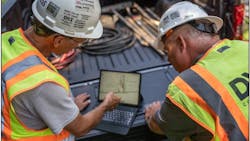How Digital Tools Enhance Job Site Safety
By Jim Goss, Senior Safety Consultant, HCSS
As the focus on construction safety intensifies, equipment-using organizations are moving beyond compliance to culture change, embedding safety into the fabric of daily operations. These six trends and factors are leading to a stronger focus on EHS (Environmental, Health, and Safety) in construction.
Why is construction safety important?
- Stricter regulations. Regulatory authorities such as the Occupational Safety and Health Administration (OSHA) are intensifying their oversight with a significant push for compliance with new regulations addressing issues such as heat, mental health, and union participation in safety inspections. This increased regulatory scrutiny demands a more systematic approach to safety management. Additionally, fines per incident have doubled in recent years, dramatically increasing the cost of noncompliance.
- Rising costs of insurance and risk of litigation. As insurance costs soar, companies are pressured to control or reduce their Experience Modification Rate (EMR). A litigious society further escalates the risk of litigation, making safety an even more critical concern. Proactive measures such as regular safety audits, employee training programs, and adherence to regulatory standards can mitigate these risks. Extensive documentation of safety protocols and incidents is also crucial in defending against potential litigation and controlling insurance costs.
- Contractor expectations. Contractors, now more safety-conscious, demand higher safety standards on sites to manage their insurance costs and mitigate litigation risks. This shift requires construction companies to adopt stringent safety policies, necessitates having dedicated safety personnel on-site, and heightens the need to document everything thoroughly.
- Labor challenges. The shrinking labor pool and limited construction knowledge among new recruits underscores the need for comprehensive training. The declining trend of construction as a multi-generational family business further complicates this issue, necessitating a focus on creating a safe and attractive work environment for new generations.
- Culture of care. Initiatives to improve the overall employment experience are becoming more prevalent. A culture that prioritizes safety is essential to retain workers and foster a sense of community and responsibility among them.
- Professionalism in safety management. The increasing emphasis on safety within the construction industry is elevating working environment standards and positioning safety management as a highly sought-after career path.
The focus on creating a safer work environment has become central to the operation of construction companies. But how can technology, particularly software tools, significantly enhance safety?
How can technology enhance safety?
The use of tablets and smartphones in the worksite is rapidly becoming widespread.
Tablets are increasingly used for a wide variety of crucial functions in construction projects. For example, site plans can be easily accessed and updated in real time, allowing for immediate adjustments to be made as needed. Digital logs facilitate the management of preventive maintenance schedules, ensuring timely equipment servicing to prevent unexpected breakdowns. Digitizing maintenance records also offers a comprehensive history of each piece of equipment's upkeep, enhancing management and accountability. Tablets also facilitate the viewing of 3D models of ongoing projects, enabling teams to visualize the result and adjust their work accordingly.
Safety apps are available to turn tablets and smartphones into safety-enhancing tools that can be integrated into daily routines.
How does safety software work?
Safety largely depends on the leaders in the field: foremen and safety managers. Their commitment to prioritizing safety and willingness to integrate digital tools into daily operations are critical for promoting widespread adoption.
The construction industry stands at a pivotal crossroads as an aging workforce and the retirement of seasoned professionals demands the replacement of a wealth of experience. It simultaneously opens the door to a unique opportunity, however. As older workers step back, Millennials and Generation Z are entering the workforce, bringing with them a natural ease with technology.
The rapid integration of software tools makes a significant difference in enhancing safety and improving efficiency in every stage of the project and will only continue to grow with the support of a generation already in tune with technological innovation.
This transition sets the stage for a dynamic, collaborative learning environment where the digital fluency of younger workers can be leveraged to introduce their older colleagues to the benefits of technology, thereby accelerating the adoption of smarter, more innovative, and more efficient ways of working.
Conversely, the older generation has a wealth of industry experience and knowledge but often hesitates or even resists new technological tools. Once they adapt, however, long-time employees discover that technology enhances their efficiency and work quality, which can extend their careers by making tasks easier.
Additionally, the infusion of new technology not only attracts younger generations who prefer digital workplaces but also raises the prestige of construction jobs, making it a more appealing employment path.
The journey toward a safer job site is ongoing, but with the advent of digital tools and software solutions, companies now have the power to make significant strides. By leveraging technology, construction companies can not only meet the industry’s evolving demands but also protect their most valuable asset: their workforce.


